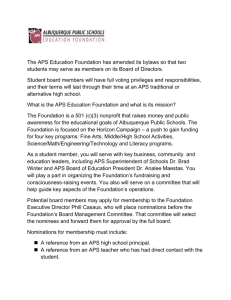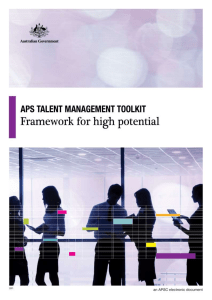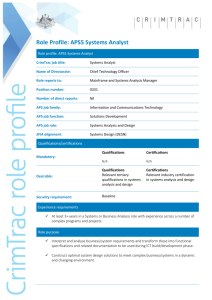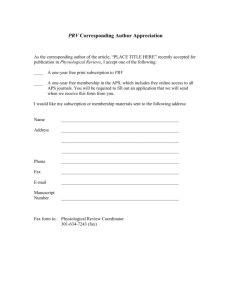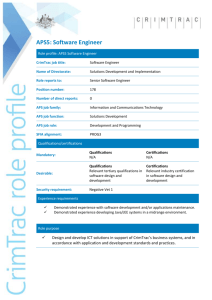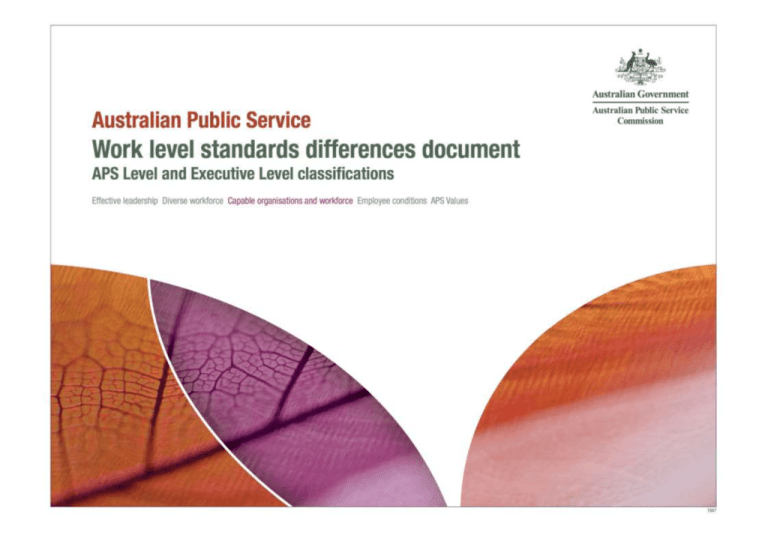
© Commonwealth of Australia 2013
All material produced by the Australian Public Service Commission (the Commission) constitutes Commonwealth copyright administered by the Commission. The Commission reserves the
right to set out the terms and conditions for the use of such material.
Apart from any use as permitted under the Copyright Act 1968 and those explicitly granted below, all other rights are reserved.
Unless otherwise noted, all material in this publication, except the Commission logo or badge, the Commonwealth Coat of Arms, and any material protected by a trade mark, is licensed
under a Creative Commons BY Attribution 3.0 Australia licence.
Details of the licence are available at <http://creativecommons.org/licenses/by/3.0/au/>.
Attributing Commission works
Use of Commission material licensed under a Creative Commons BY Attribution 3.0 Australia licence requires you to attribute the work in the manner specified by the Commission (but not
in any way that suggests that the Commission endorses you or your use of the work). Almost any form of words is fine provided that you:
provide a reference to the publication and, where practical, the relevant pages
make clear whether or not you have changed Commission content
make clear what permission you are relying on, by including a reference to this page or to a human-readable summary of the Creative Commons BY Attribution 3.0 Australia licence
do not suggest that the Commission endorses you or your use of our content.
For example, if you have not changed Commission content in any way, you might state: ‘Sourced from the Australian Public Service Commission publication APS work level standards
differences document APS and EL classifications. This material is licensed for reuse under a Creative Commons BY Attribution 3.0 Australia licence.’
If you have made changes to Commission content, it would be more accurate to describe it as ‘based on Australian Public Service Commission content’ instead of ‘sourced from the
Australian Public Service Commission’.
Enquiries
For enquiries concerning reproduction and rights in Commission products and services, please contact communicationsunit@apsc.gov.au.
© Commonwealth of Australia 2013
P a g e |2
Australian Public Service Work Level Standards – Differences Document
Purpose
This document summarises some of the key responsibilities and requirements that differentiates each classification level from the others. For each classification level, the list
describes role characteristics that are introduced at that level or that increase in complexity relative to the classification level below. The document is not an exhaustive list of job
tasks, rather, it focuses on those activities that differentiate job levels. A full description of expectations at each classification level can be found in the Work Level Standards.
APS 1
APS 2
Knowledge
Advice
Results
Planning
Provide procedural
advice and respond
to straightforward
requests for
information
Provide advice on
procedural and
technical issues
relating to
immediate work area
APS 3
© Commonwealth of Australia 2013
Contribute ideas to
the development of
work area goals and
objectives
APS 5
APS 6
EL 1
Technical expertise
that contributes to
business unit
outcomes
Provide advice using
established policy
and procedures as a
guide
Provide sound
advice which
influences decisions
by others
Provide professional Provide accurate
specialist advice
and policy advice
within an area of
specialisation
Complete allocated
tasks, monitor work
flow and review
work of less
experienced
employees
Accountable for
tasks and decisions.
Support less
experienced
employees to
achieve goals by
providing guidance
and quality
assurance
Set priorities and
Responsible for the
ensure quality of
achievement of own
outputs for the work and team outcomes,
area
monitor team
progress and follow
through to deliver
quality outcomes
Anticipate and
establish priorities,
monitor progress and
work to deliver
agency functions or
a program within an
area of responsibility
Participate in
strategic planning
and decision making
within the work area
Develop objectives
for short-term tasks
and participate in
strategic planning
for longer-term
initiatives
Develop objectives
for short-term tasks
and contribute to
strategic planning
for longer-term
initiatives
Contribute to agency
wide strategic
planning. Set
strategic direction,
develop long-term
plans and implement
strategies for work
area
Responsible for
planning own work
goals and priorities
that align with and
achieve own and
team outcomes
Expertise and
Expertise across a
technical knowledge broad range of
in a specialist area
activities potentially
relating to the work
of different program
areas
EL 2
Functional expertise Functional expertise
that contributes to
in a specific area that
team goals
contributes to team
goals
Complete allocated tasks, within required Set priorities,
timeframes and compliant with set
complete allocated
procedures
tasks, make
decisions within
defined parameters
relating to the area
of responsibility
Plan for the
achievement of own
results
APS 4
Strategic level of
specialist,
professional and/or
technical expertise
potentially relating
to the work of
different program or
discipline areas
Provide expert
Provide advice that
advice internally and influences strategic
direction
externally to the
organisation
Determine strategic
direction for the
work area and align
longer-term planning
with agency goals
and objectives
P a g e |3
APS Work Level Standards – Differences Document
APS 1
Innovation,
Change &
Business
Improvement
Risk
Management
Complexity
Legislation
Guidance
Participate in the
implementation of
change and
contribute to the
improvement of
quality and
efficiency of
services and work
processes
APS 2
Contribute ideas and
participate in the
implementation of
change in the
workplace
Identify and manage risks that affect
day-to-day tasks
Required to
undertake basic and
routine tasks
Required to
undertake
straightforward
tasks
Have basic understanding of relevant
legislation and policy frameworks
Works under close
supervision and
direction against
clearly defined and
established
priorities and
procedures
© Commonwealth of Australia 2013
Works under direct
guidance against
established priorities
and procedures
APS 3
APS 4
APS 5
APS 6
EL 1
EL 2
Identify and lead
innovation
solutions. Provide
leadership in
implementing and
promoting change
and continuous
improvement in the
workplace
Contribute to the
improvement of
quality and
efficiency of
services
Contribute new
ideas and identify
opportunities to
improve the
efficiency of
business processes
Apply innovative
initiatives and
contribute to change
and to the
improvement in
quality and
efficiency of
services
Propose and
facilitate innovation
initiatives and
contribute to
business
improvement
strategies and
change in the
workplace
Generate new ideas
approaches and
strategies.
Implement change
and business
improvement
strategies in the
workplace
Perform risk
analysis activities
and develop
compliance
strategies
Identify and
mitigate risks which
impact of own and
team outcomes
Assist with
maintaining risk
management
programs
Perform quality
assurance of risks
and treatments for
area of
responsibility
Undertake risk
Identify and manage
management and
risk in all areas of
assessment activities decision-making
for area of
responsibility
Required to
undertake
straightforward
tasks. Some tasks
may have an
element of
complexity
Required to
undertake tasks of
moderate
complexity
Required to
Required to
undertake work that undertake work that
is complex in nature
is moderately
complex to complex
in nature
Required to
undertake work that
is very complex or
sensitive
Required to
undertake work with
a high level of
complexity or
sensitivity
Understand relevant Have a good
legislation and
understanding of
policy frameworks
relevant legislation
and policy
frameworks
Maintain a welldeveloped
understanding of
relevant legislation
and policy
frameworks
Have an in-depth
understanding of
and compliance with
relevant legislation
and policy
frameworks
Have an extensive
understanding and
compliance with
relevant legislation
and policy
frameworks
Have an excellent
understanding and
articulate legislative,
financial and
administrative
frameworks and
government
decision-making
Works under
general supervision
and direction against
established priorities
and procedures.
Exercise some
autonomy about
how work tasks are
performed
Works under limited
direction and makes
independent
decisions relating to
an area of
responsibility
Works under limited
direction with
opportunity for
autonomy and
accountability in
interpreting policy
and the application
of practices and
procedures
Operates under
broad direction
exercising a
considerable degree
of independence
Operates under
broad direction and
exercises a
significant degree of
independence
Works under
general direction.
Exercises some
discretion with
respect to how
procedures and
guidelines and
interpreted and
applied
P a g e |4
APS Work Level Standards – Differences Document
APS 1
APS 2
Decisions
Make decisions that
are based on defined
outcomes, priorities
and performance
standards
Make decisions of a
procedural or
administrative
nature
Impact of
decisions
made
Research
APS 3
APS 4
APS 5
APS 6
EL 1
EL 2
Make decisions
within defined
parameters and sets
new precedents
based on sound
subject matter
knowledge and
professional
judgement
Make decisions
using good
judgement, expertise
and knowledge. Is
governed by the
application of
regulations, best
practice principles
or the agency’s
operating
instructions and
procedures
Make decisions that
are based on
professional
judgement,
evaluating risks and
in the context of a
complex and
changing
environment
Make balanced
decisions using
professional
judgement,
evaluating
ambiguous and
incomplete
information,
factoring in risks
and being sensitive
to the context
Make decisions
within defined
parameters and
following
established
procedures and
protocols
Make decisions
within defined
parameters relating
to the area of
responsibility
Decisions generally Decisions have a
have a minor impact low impact on the
on own work area
work area or
specific function
Decisions are likely
to impact the work
area or specific
function
Decisions impact on Decisions may
the work area or
impact on the
specific function
overall outcomes for
the work area
Decisions have a
medium to high
level of impact on
the work area;
however, the impact
on agency
operations and
resources is usually
limited
Decisions have a
high level of impact
on the functional
area and the
potential to impact
more broadly on
agency operations
and externally
Decisions may have
significant impact
on the day-to-day
operation of the
work area and other
parts of the agency;
and/or a direct and
significant impact
on the outcome of a
program or major
project for the
agency
Roles may play an
administrative
support role to other
employees involved
in research and
investigative work
Roles may
undertake some
research and
analysis activities
Roles may conduct
research and
analysis activities
and report on
findings
Perform research
and analysis to make
decisions that
involve complex or
escalated issues,
longer-term
planning and liaison
with other sections
on policy, project or
operational issues
Work with a focus
on research, analysis
and judgement to
manage complex
issues
Undertake complex
analysis and
interpretation and
apply significant
judgement in
choosing a course of
action to manage
highly complex
and/or sensitive
issues
© Commonwealth of Australia 2013
Roles may
undertake
preliminary work
for research tasks in
a specific area of
knowledge or
specialisation
Perform objective
and systematic
research and
analysis to obtain
accurate conclusions
based on evidence
P a g e |5
APS Work Level Standards – Differences Document
Stakeholder
relationships
APS 1
APS 2
APS 3
APS 4
APS 5
APS 6
EL 1
EL 2
Support effective
stakeholder
relationships. Liaise
with stakeholders
and respond to
routine matters
Support and
maintain effective
stakeholder
relationships. Liaise
and respond to
routine enquiries or
straightforward
matters
Cultivate effective
stakeholder
relationships. Liaise
with stakeholders
and assist to resolve
straightforward
matters
Build rapport and
maintain stakeholder
relationships. Liaise
with stakeholders
and assist to resolve
moderately complex
issues
Develop and
maintain internal
and external
relationships. Liaise
with stakeholders on
policy, project or
operational issues
responding to
stakeholder needs
and expectations
Develop and support
complex
relationships with
internal and external
stakeholders.
Manage
relationships with
stakeholders to
achieve work area
and agency goals.
Anticipate and
respond to
stakeholder needs
and expectations
Develop and
manage a range of
stakeholder
relationships.
Engage and
collaborate with key
stakeholders to
identify
opportunities,
achieve outcomes
and facilitate
cooperation
Develop and
manage key
strategic
relationships with a
broad range of
stakeholders,
promoting the
agency’s business
objectives and
communicating the
strategic direction
and vision of the
agency
Represent the work
area at internal
meetings
Represent the work
area at internal and
external meeting
and conferences
Represent the work
area or agency at
meeting,
conferences or
seminars
Represent the
agency by
promoting its
interests at
community and
cross-agency levels
Represent and
explain the views of
the agency at crossagency meetings
and other forums
Represent and
negotiate on behalf
of the agency to
advance the
agency’s interests in
cross-agency, interjurisdictional,
international and
other forums
Roles may provide
mentoring, on-thejob training, and
provide advice and
guidance on
procedural matters
to a team
Roles may be
responsible for
coaching and
mentoring and
identifying training
needs for a team
Role may be
responsible for
identifying training
needs for a team,
and participating in
performance
management
processes, including
providing
performance
feedback
Roles may be
responsible for the
supervision and
development of
lower classification
levels; building
team capacity
through coaching,
performance
feedback; and
encouraging career
development
Roles may be
responsible for
building capability
in a team
environment
through coaching
others, providing
performance
feedback, conflict
resolution and
encouraging career
development
Role may be
accountable for
developing,
coaching and
mentoring
employees,
performance
management,
conflict resolution,
and identification of
training needs
Represent the
agency
Supervision /
Management
Roles have no
supervisory
function, although
may assist others to
become familiar
with routine work
practices and tasks
© Commonwealth of Australia 2013
Roles have a
minimal supervisory
function but may
provide on-the-job
training to develop
the skills of lower
classification levels
on routine work
matters and
practices
P a g e |6




